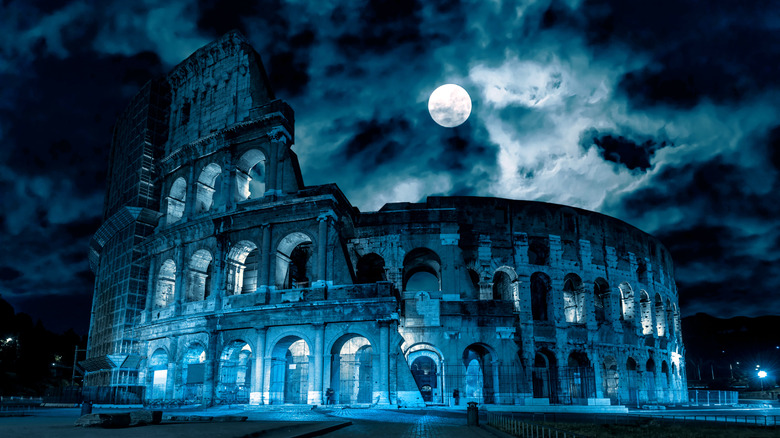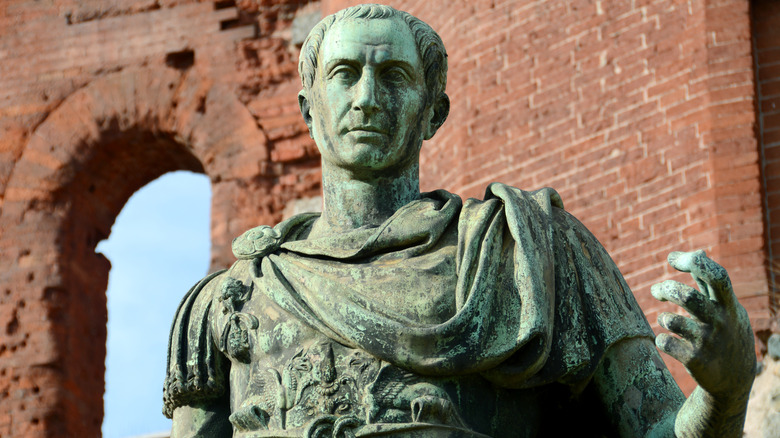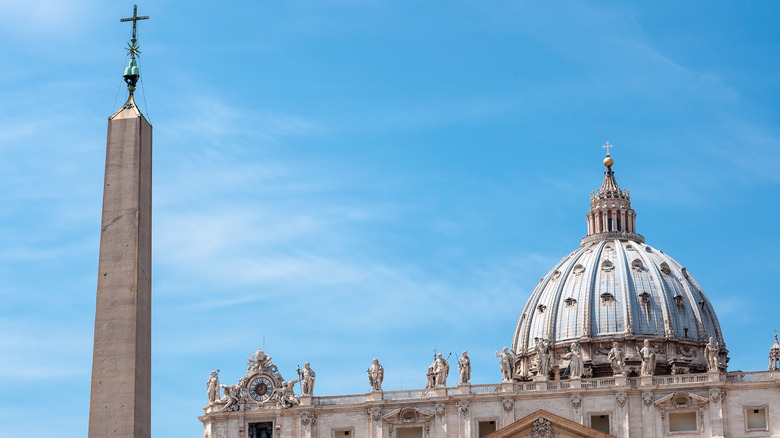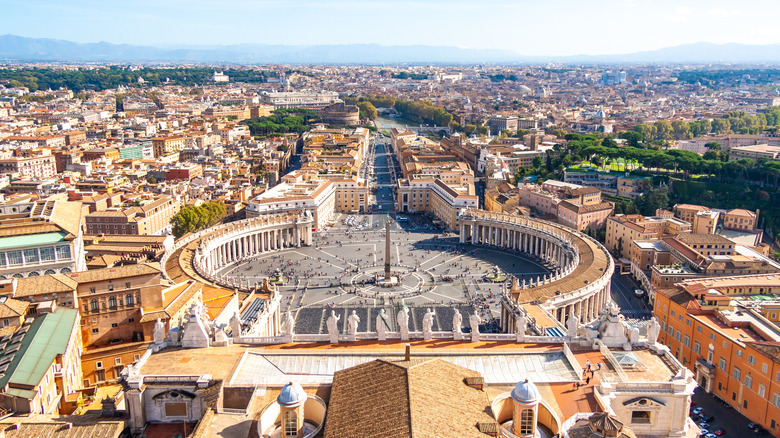Here's Where You Can Allegedly Encounter The Ghost Of Julius Caesar
At this point, most of us have picked up bits and pieces of Julius Caesar's story. He was the first laurel crown-wearing emperor of Rome, a tyrant who invaded Egypt and slept with Cleopatra, murdered dictator vis-à-vis his buddy Brutus and the Ides of March ("Et tu, Brute?"), and guy whose name is all over creamy salad dressing. If Caesar's ghost hasn't literally haunted us, then stories of the man and the specter he cast over Western civilization certainly have. This might be a better definition of "ghost" than anything.
But even Caesar's ghost — the actual, disembodied consciousness (if such things exist) — has its own story, as Italy Guides summarizes. Seemingly attached to his ashes as they were housed in a lead ball at the top of an obelisk in Heliopolis (now Cairo), Egypt, the ghost traveled back to the Vatican along with Pope Sixtus V in 1585, and began roaming all sorts of Roman places.
While we have no way of knowing how often tales of Caesar's ghost cropped up in the centuries following his death in 44 B.C., we at least know that Shakespeare included one such Caesarian specter in "Julius Caesar" (1599), when Caesar's ghost appeared to Brutus. From there, Caesar's ghost continued its bizarre path towards its final, current resting place.
The ghost of a dictator
Before we fast-forward to Caesar's 2022 spiritually sojourned hotspot, we've got to travel back 2,100 years or so. Gaius Julius Caesar (100 – 44 B.C.) was raised in a wealthy aristocratic family in a troubled, politically unstable time in Roman history (via PBS). He must have taken the lessons of his youth to heart, because he rose to power through a combination of brutality, intimidation, cunning, and deft oratory.
As World History says, Caesar became head of his family at age 16 when his father died, and went on to prove his military prowess in the army. One well-known anecdote describes him getting kidnapped by pirates for ransom in 75 B.C. and swearing that he'd hunt them down for the offenses they'd committed against his family. This wasn't just a brazen threat — he actually did it. Later on he found them, slit their throats, had them crucified, and that was that.
Caesar became Rome's military tribune and forged an alliance with the war hero Pompey the Great (whom he later killed) and Rome's wealthiest man, Marcus Licinius Crassus. He then ruthlessly campaigned in Gaul (58 – 50 B.C.), and wielded his renown from that campaign to assault Rome with an army in 49 B.C. From there he marched on Egypt, claimed it for himself, had a son with Cleopatra, and returned to Rome in 44 B.C. to assume the title "Dictator Perpetuus," or "dictator for life." That very year he was assassinated.
Interred in lead at the tip of an obelisk
Julius Caesar was cremated at the Roman Forum in a massive event akin to a sacrificial feast. Amidst funereal games and public riots where citizens threw whatever possessions they could onto Caesar's blazing death pyre, the once-dictator was incinerated on a massive bier decked out with a "gilded shrine" modeled after a temple of Venus. It contained an ivory couch and a pillar hung with the robe that Caesar wore when he was murdered (per Imperium Romanum).
Some say Caesar's ashes were interred at the Forum, in "The Temple of the Divine Julius" erected in his honor. You can still visit this site today, as Trip Advisor shows. At the time when the temple was built, however, it was illegal to inter people within the city's boundaries. Accounts such as "Lives of the Caesars," written by the Roman historian Suetonius and published in A.D 121 — a full 165 years after Caesar's death — point to a place called "The Field of Mars" as Caesar's ashes' resting place. Some believe that the ashes were buried at a temple on Capitoline Hill, while others believe they were interred at Piazza di Monte Citorio near a column raised to Emperor Marcus Aurelius.
Others believe that Caesar's ashes wound up in a lead ball at the tip of a mysterious obelisk in Heliopolis, Egypt, which was moved by Emperor Caligula to Rome in A.D. 37 (via PBS).
We repeat: do not open the cursed orb
When Caligula moved the obelisk supposedly containing Caesar's ashes to Rome, he placed it in a literal circus called the "Vatican Circus," or the "Circus of Nero." This was the site where numerous Christians were martyred, including, as some believe, St. Peter himself (via PBS). While other obelisks were later toppled, this one was left standing as the "last witness" to an important historical time.
It seems that the obelisk remained undisturbed for about 1,500 years, until Pope Sixtus V moved it to its current location in front of the Basilica of St. Peter in 1586. At some point during the move from the Vatican Circus to the future Vatican City, legend says that Sixtus just couldn't help but crack open the lead orb on top (via Italy Guides). Reports indicate that there was indeed "dust" inside, but that's the extent of it.
To add to the drama of potentially unleashing a dictator's spirit and curse, the obelisk came to near-catastrophe on the day of its relocation. As Advocacy describes, the obelisk's ropes almost snapped under the strain of its weight, but a gallant sailor from Genoa put his back into it, so to speak, and the obelisk was spared. The entire time, Sixtus ordered the gathered crowd to stay still and silent on punishment of death. The obelisk remained untouched until 1817, when a sundial was added to it.
Supervillain meets superhero
1599 gives us the first historical mention of "Caesar's ghost." He didn't materialize in Rome, however, or near any supposed resting site. He coalesced on stage when Shakespeare debuted "Julius Caesar" a mere 13 years after the mysterious obelisk of Heliopolis was moved from the Vatican Circus. Following Caesar's assassination in the play, his ghost appears to Brutus in act 4, scene 3 to guilt him for being a traitor (available in full on The Folger Shakespeare website). While this is fiction, and conforms to Shakespeare's "ghosts represent guilt" motif that also shows up in "Macbeth," it at least marks an instance of the forthcoming Caesar's ghost legend.
Another time Caesar's ghost shows up in narratives thousands of years after his death? Superman comic books. Yes, that's right. Volume 1, issue 91 of "Superman" from 1954 depicts Supes facing off against a literal, ephemeral ghost of Julius Caesar (via Comic Book Realm). Actor Julian Noa, who voiced Clark Kent's editor Perry White, first deployed the phrase "Great Caesar's Ghost!" back in 1946 for a radio show reading of "Superman," as CBR explains. From that point, "Great Caesar's Ghost!" became the character Perry White's catchphrase, similar to other old-timey exclamations like "Great Scot!" or "Good Heavens!"
Noa didn't make up the phrase "Great Caesar's Ghost!" though. It was already in popular circulation by then, meaning that it had been milling around in language and consciousness for some time before.
Ghostly visions in the Colosseum
So where exactly does legend place Julius Caesar's ghost and its hauntings, at present? Why, the Colosseum, of course (via Italy Guides). Tales don't describe why Caesar would choose to inhabit the Colosseum (it was built around A.D. 70, over 110 years after his death, via Britannica), other than that it might remind him of heartwarming sights of bloodshed.
Tourist sites like Different Italian Journey go a different route and also up the apparitional ante. They describe, at number six on their "ghost tour" list, St. Peter's Basilica being Caesar's ghost's haunting ground. They also describe an evil column inside the cathedral that had demons bound to it and was brought to the basilica from Solomon's Temple in Jerusalem. But at this point things are just getting ridiculous, so we'll leave it at that.
As all this history, myth, and superstition illustrates, we've indeed been haunted by Caesar's ghost: the legacy of a dictator whose legend preoccupies the world over 2,000 years after his death.





